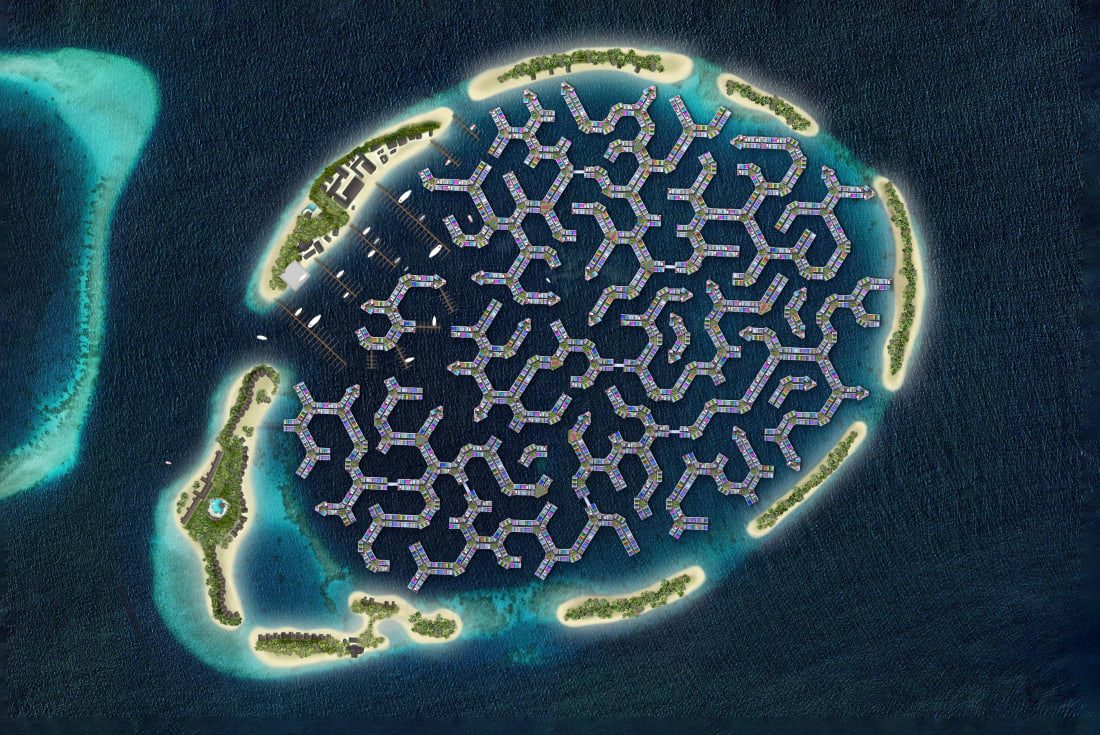From
the Indian Ocean's depths, Accity is rising. A floating metropolis large enough
to house 20,000 people is being built in a turquoise lagoon only 10 minutes by
boat from Male, the capital of the Maldives.
The
city will be made out of 5,000 floating structures, including homes,
businesses, restaurants, and schools, with canals snaking in between them in a
pattern reminiscent of brain coral. The first apartments will be unveiled this
month, with inhabitants expected to move in at the beginning of 2024. The
entire city is expected to be finished by 2027.
According
to CNN, the project -- a joint venture between property developer Dutch
Docklands and the Government of the Maldives -- is not meant as a wild
experiment or a futuristic vision: it's being built as a practical solution to
the harsh reality of sea-level rise.
An
archipelago of 1,190 low-lying islands, the Maldives is one of the world's most
vulnerable nations to climate change. Eighty percent of its land area is less
than one meter above sea level, and with levels projected to rise up to a meter
by the end of the century, almost the entire country could be submerged.
But
if a city floats, it could rise with the sea. This is "new hope" for
the more than half a million people of the Maldives, said Koen Olthuis, founder
of Waterstudio, the architecture firm that designed the city. "It can
prove that there is affordable housing, large communities, and normal towns on
the water that are also safe. They (Maldivians) will go from climate refugees
to climate innovators," he told CNN.
Hub of floating architecture
Olthuis
has spent his entire life near water. He was born and raised in the
Netherlands, where a third of the country is below sea level. It seemed only
logical to mix the two, he added, as his father hails from a line of architects
and engineers and his mother's family were shipbuilders. Olthuis established
Waterstudio, an architecture business solely focused on creating structures on
water, in 2003.
Even
though there were early indications of climate change at the time, it wasn't
thought to be a significant enough problem to warrant starting a business,
according to him. Space was the main issue at the time since cities were
growing but there was a shortage of adequate land for new urban development.
Nevertheless,
he claimed that in recent years, climate change has acted as "a
catalyst," bringing floating architecture into the mainstream. More than
300 floating homes, workplaces, schools, and medical facilities have been
created by Waterstudio during the past 20 years.
With
floating parks, a floating dairy farm, and a floating office building that
houses the Global Center on Adaptation (GCA), an organization dedicated to
scaling climate adaptation solutions, the Netherlands has emerged as the
movement's epicenter.
The
CEO of GCA, Patrick Verkooijen, views floating architecture as a feasible and
wise financial response to sea level rise.
"The
cost of not adapting to these flood risks is extraordinary," he told CNN.
"We have a choice to make: we either delay and pay, or we plan and
prosper. Floating offices and floating buildings are part of this planning
against the climate of the future."
Last
year, flooding cost the global economy more than $82 billion, according to
reinsurance agency Swiss Re, and as climate change triggers more extreme
weather, costs are expected to rise. One report from the World Resources
Institute predicts that by 2030, urban property worth more than $700 billion
will be impacted annually by coastal and riverine flooding.
But
despite momentum in recent years, floating architecture still has a long way to
go in terms of scale and affordability, said Verkooijen. "That's the next
step in this journey: how can we scale up, and at the same time, how can we
speed up? There's an urgency for scale and speed."
A normal city, just afloat
Building
a city for 20,000 people in less than five years is the goal of the Maldives
project. Oceanix City in Busan, South Korea, and a group of floating islands
built by the Dutch company Blue21 in the Baltic Sea are two other projects for
floating cities that have been announced, but none compare to this project's
scope and timeline.
With
its dwellings painted in a rainbow of colors, expansive balconies, and
beachfront views, Waterstudio's city is intended to draw the locals. In
addition to using boats to move around, residents can also travel around the
sandy streets on foot, bicycles, electric scooters, or buggies.
It
offers space that is hard to come by in the capital -- Male is one of the most
densely-populated cities in the world, with more than 200,000 people squeezed
into an area of around eight square kilometers. And prices are competitive with
those in the Hulhumalé (a manmade island built nearby to ease overcrowding) --
starting at $150,000 for a studio or $250,000 for a family home, said Olthuis.
The
modular units are constructed in a local shipyard, then towed to the floating
city. Once in position, they are attached to a large underwater concrete hull,
which is screwed to the seabed on telescopic steel stilts that let it gently
fluctuate with the waves. Coral reefs that surround the city help to provide a
natural wave breaker, stabilizing it and preventing inhabitants from feeling
seasick.
Olthuis
said that the potential environmental impact of the structure was rigorously
assessed by local coral experts and approved by government authorities before
construction began. To support marine life, artificial coral banks made from
glass foam are connected to the underside of the city, which he said help
stimulate coral to grow naturally.
The
city is intended to be self-sufficient and perform all of the same tasks as one
that is located on land. On-site solar energy will be used primarily to create
electricity, while sewage will be locally processed and used as plant manure.
The city will use deep water marine cooling as an alternative to air
conditioning, which includes pumping cold water from the deep sea into the
lagoon and thereby saving electricity.
Olthuis
intends to further this kind of building by creating a fully functional
floating metropolis in the Maldives. He claimed that instead of being
"freak architecture" found in opulent settings commissioned by the
super-rich, it would be a sensible and cheap response to urbanization and
climate change.
"If
I, as an architect, want to make a difference, we have to scale up," he
said.













0 Comments